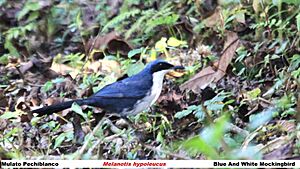Blue-and-white mockingbird facts for kids
Quick facts for kids Blue-and-white mockingbird |
|
|---|---|
 |
|
| Conservation status | |
| Scientific classification | |
| Genus: |
Melanotis
|
| Species: |
hypoleucus
|
 |
|
The blue-and-white mockingbird (Melanotis hypoleucus) is a type of bird that belongs to the Mimidae family. You can find this bird in countries like El Salvador, Guatemala, Honduras, and Mexico.
Contents
About the Blue-and-White Mockingbird
This bird is the only one of its kind, meaning it's unique! It shares its group, called a genus, with only one other bird: the blue mockingbird.
What Does It Look Like?
The blue-and-white mockingbird is about 24 to 28 centimeters (9.5 to 11 inches) long. It weighs around 68 grams (2.4 ounces), which is about as much as a small apple.
Adult birds have a dull blue color on their upper parts, like their back and head. Their wings and tail are a darker, slaty black. A cool feature is the black "mask" that covers the area around their eyes. Their belly and chest are white, which turns a bit bluish or gray on their sides. Young birds look similar, but their upper parts are gray instead of blue.
Where Does It Live?
The blue-and-white mockingbird lives all year round in parts of Mexico, Guatemala, El Salvador, and southern Honduras.
It likes many different places to live. You can find it at the edges of wet, green forests, in pine-oak forests, and in areas where new plants are growing. It also lives in both wet and dry scrublands. These birds live at high elevations, from about 900 to 3000 meters (2,950 to 9,840 feet) above sea level.
How Does It Behave?
Finding Food
The blue-and-white mockingbird mostly looks for food on the ground. It uses its beak to sweep away fallen leaves to find tasty treats underneath. While we don't know everything it eats, it seems to mostly enjoy small bugs and also eats small fruits.
Raising a Family
The breeding season for these birds lasts from at least May to August. The female bird builds the nest, which is shaped like a shallow cup. She uses strong roots and places it on a platform of sticks. Nests are usually hidden in thick bushes or small trees.
A female mockingbird usually lays two eggs. She sits on the eggs to keep them warm and cares for the baby birds when they hatch. Both the male and female birds help feed the young ones.
What Does It Sound Like?
The song of the blue-and-white mockingbird is quite unique! People have described it as an amazing mix of different bird sounds. It can include fast, short sounds, a high-pitched squeak, a whistle, and even a rough, gurgling sound. It's definitely not what you'd call a smooth or pretty song, but it's certainly interesting! They also have many different calls they use.
Is It Safe?
The IUCN (International Union for Conservation of Nature) says that the blue-and-white mockingbird is a species of "Least Concern." This means it's not currently in danger of disappearing. Even though it lives in a large area, we don't know exactly how many of these birds there are. However, if their homes are destroyed or damaged, it could become a problem for them in the future.



